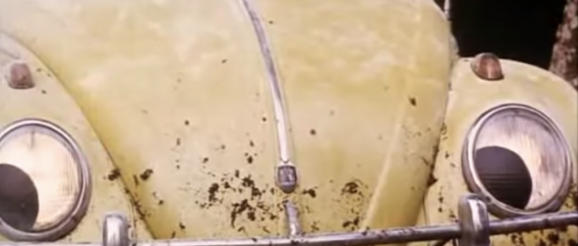From Fantasy To Innovation: The Autonomous Car in Film History

A BIG RESEARCH PROJECT ALWAYS LEADS US DOWN SOME BIZARRE RABBIT HOLES, and my current research for my MBA capstone is no exception. I’m working on a paper about the future of infrastructure in the United States, around the question of public management versus private innovation, and how the for-profit driver, no pun intended, behind the latter complicates questions of access and ownership. I must, of course, pay some attention to this autonomous vehicle thing that all the kids are talking about these days. So, I came across this bizarre film, Ein Käfer geht aufs Ganze, from 1971. The title translates roughly as “A Beetle Goes The Whole Way,” but the English language title is The Love Bug Rally. It’s more or less a ripoff of Disney’s Herbie (1968), which also deals with a racing VW Beetle imbued with magical powers.
“The East Africa Rallye”
In Käfer, one “Scotsman” James Butler arrives in Tanzania to race in the “East Africa Rallye” [sic]. Butler is portrayed as Scottish in spite of his unmistakably German accent when speaking English. The director highlights this by– I kid you not- periodically playing bagpipe music and having him appear in tartan. The Bug’s ownership is somewhat unclear, but it seems to change hands without much explanation. This doesn’t ultimately seem terribly important to the nonexistent plot of the film. It isn’t really clear whence the car gets its magical powers, which gives it anthropomorphic eyes and some sort of ability to triumph over its rivals, either technologically or mechanically, but the technological or mechanical superiority is implied as an alternative to Disney’s Herbie, another vehicle imbued with an albeit more playful, fantastical, and “pure” magic.
The English language title of the film is almost certainly a reference to its predecessor Herbie, which was released only a few years prior (and also has to do with racing a magical VW Bug). Käfer’s abilities are made apparent in scenes where the car gets itself out of impossible ruts without human input– or displays fantastical abilities to navigate on improbable surfaces like beach sand.
Käfer in the context of German Cinema
One might be inclined to give the filmmakers some benefit of the doubt. After all, these were exceptionally dark times for German Cinema. The country struggled to define its artistic direction amid the strain of physical and psychological divisions, 1961-1989. (I sat through more than one or two Rainer Werner Fassbinder films in undergrad and let me tell you that they are brutal). But really, nah, we don’t really have to give them a break: the casual racism and animal abuse, uh, do not hold up terribly well. (Spoiler alert: the Bug actually loses the race. But I think we can all agree that the real race was the endangered jungle animals we messed with along the way, right?).
Käfer gets an utterly lackluster 5.0 / 10 on IMDB, and this is arguably somewhat generous. There are, however, some great shots of the Serengeti and environs, and it’s honestly got some pretty impressive driving, including some scenes with the Bug racing a white and fire engine red hovercraft that looks a bit like Charles Joseph Fletcher’s streamline moderne masterpiece Glidemobile.
Herbie vs. Käfer vs. … James Bond?
Playful elements aside, it is clear that director Rudolf Zehetgruber is more interested in portraying a technologically advanced vehicle than a magical one, although this really comes through more in Ein Käfer gibt Vollgas (lit. “A Bug Gives Full Gas”), released the following year. Zehetgruber has adopted a much more James Bond-y approach– indeed, the lead’s name in both films is actually Jimmy Bondi- in which Käfer is functioning as some sort of crime-fighting, secret agent-mobile. Let’s remember that this era was peak James Bond, peak John Le Carré, and peak Cold War. Spies were all the rage, VW bugs were all the rage. Why not combine them?!
Suffice it to say, you do not need to watch either of these. I just wanted to see how midcentury cinema dealt with the then-quite-radical idea of a car that drives itself.
Runners-Up
There were also more serious contenders for the dubious honor of “ridiculous portrayals of Autonomous Vehicles In Science Fiction And Stuff.” The tour de force of Knight Rider (1982-86), starring David Hasselhoff, similarly embraces the autonomous car as a central driver of the largely nonexistent plot. KITT (Knight Industries Two Thousand) is a 1982 Pontiac Firebird Trans Am that helps Hasselhoff, you know, fight crime, or whatever the hell it is that he actually does. KITT even has an evil rival, whose name is– wait for it- KARR (Knight Automated Roving Robot). Tangentially, the idea of the evil AI foil to the good AI echoes further in Star Trek: The Next Generation (1987-1995), in which benevolent android and Federation officer Data encounters his “brother” Lore, a diabolical foe.
Weird and occasionally quite magical stuff was going on in science fiction in the 1980’s. By the end of the decade, the trend is out in full force. Total Recall (1990) features automated “Johnny Cab” taxis, reminiscent perhaps of Johnny 5, the sentient robot featured in Short Circuit (1986). And the cyberpunk cop thriller Demolition Man (1992) similarly envisions an early 21st century society that has autonomous cars (lol) and nonviolent police officers (double-lol and a rofl, am I right, ladies?).
The post From Fantasy To Innovation: The Autonomous Car in Film History appeared first on The Handbuilt City.
